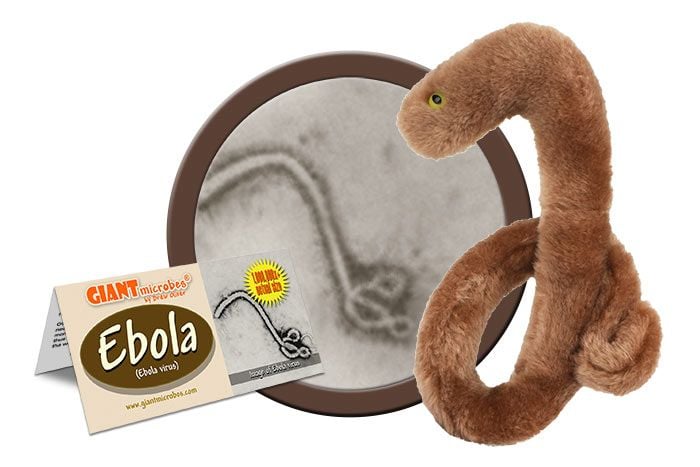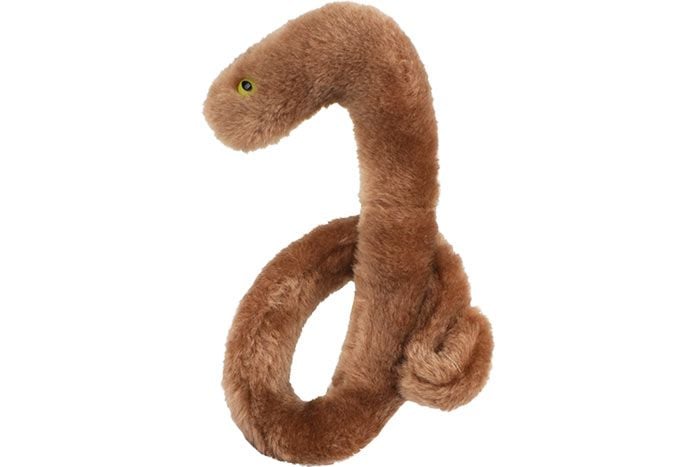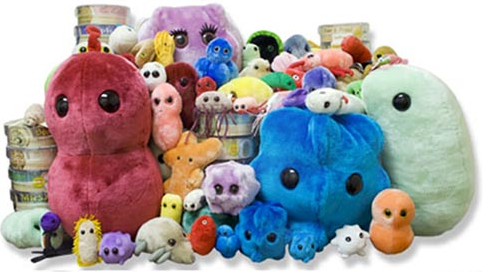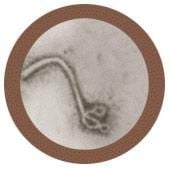Ebola (Ebola Virus)
Product Details
Additional Information
| Sizes | Giantmicrobes are based on actual microbes, cells, organisms and other critters, only 1,000,000 times actual size! Gigantic (GG) 16-24" XL (XL) 10-15" Original (PD) 5-8" Keychain (KC) 2-4" with clip |
|---|---|
| Materials | Plush from all new materials. Stuffed with polyester fiber fill. Surface washable: sponge with water & soap, air dry. |
| Packaging | Each plush microbe includes a printed card with fun, educational and fascinating facts about the actual microbe or cell. |
| Safety | Every product meets or exceeds U.S. and European standards for safety. For ages 3 and up. |
All about Ebola (Ebola Virus)
FACTS: Although the origins of Ebola hemorrhagic fever are unknown, the Ebola virus was first recognized in 1976 near the Ebola river in the Congo in Africa.
You do not want to get Ebola. A short incubation period of 2 to 21 days presages symptoms which include fever, aches, sore throat, and weakness, followed by diarrhea, stomach pain, vomiting, and both internal and external bleeding. And then, for between 50-90% of victims, death.
Because the initial symptoms mimic those of many diseases, it can be difficult to diagnose Ebola correctly. And for decades, cases occurred only sporadically. In several years since 1976, there were no identified cases -- and when there were cases, they were often the result of nosocomial transmission (transmission in a health-care setting).
However, in 2014 Ebola shed its secretive persona and became a widespread global menace, demanding public media and political attention. Though Africa continues to suffer the brunt of this villainous virus, the world population is now also acutely aware of its danger.
Nevertheless, given the number of microscopic malefactors in the world, don’t worry: if you’re under the weather, you probably have something else.
| Name | The virus gets its name from the region it was first discovered, in a village near the Ebola River in the Democratic Republic of the Congo. |
|---|
| Actual Size | 80 x 1000 nanometers, or 4000 times smaller than a grain of rice! |
|---|
| Where It Lives | Ebola is a deadly disease caused by the Ebola virus. Scientists believe that Ebola virus spreads from animals to humans through direct contact with an infected bat or monkey, known as a spillover event. The virus spreads easily from person-to-person and outbreaks happen quickly when friends, family, and healthcare providers caring for Ebola patients come in contact with contaminated body fluids like blood, feces, and saliva. It’s not an air-borne virus, but it can spread through large contaminated droplets or splashing. |
|---|
| Symptoms | Fever, fatigue, muscle pain, vomiting, diarrhea, rash, and internal and external bleeding. |
|---|
| Cure | Vaccines and drugs are currently under development, but there is no proven treatment available yet. |
|---|
| History |
1976: A group of scientists led by Belgian microbiologist, Peter Piot, were the first to identify the virus and document the disease in the Democratic Republic of the Congo. Big Outbreaks: 1976: First documented outbreak in Sudan and the Democratic Republic of the Congo Recent Outbreaks: 2014: The largest known Ebola outbreak started in Guinea and spread to Sierra Leone, Liberia, Nigeria, and the U.S. There were over 28,000 cases of Ebola worldwide. That’s enough to fill up over half of Yankee Stadium! |
|---|
| Fascinating Facts |
Dr. Kent Brantly caught Ebola in West Africa and was the first American to be treated for it in the U.S. After surviving the disease, he donated his blood to help two other patients infected with Ebola in the U.S. The famous 1995 movie, Outbreak, is a fictional story inspired by the Ebola Virus. Famous people who died of it: 2014: Thomas Duncan was the first person to be diagnosed with Ebola in the U.S. |
|---|














